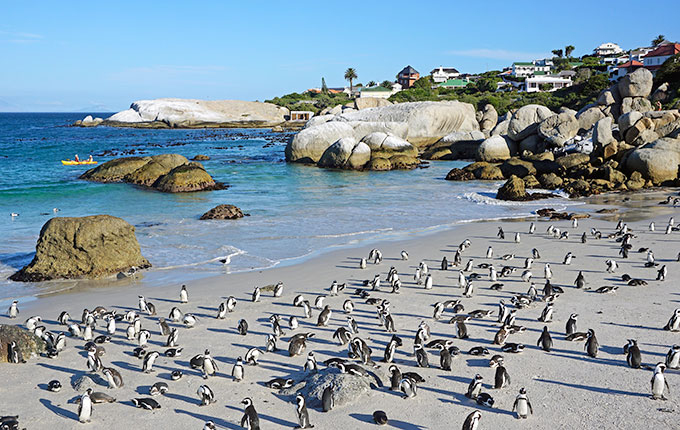
Confessions of a Technophobe, New Series 4
This blog is dedicated to the memory of Bruce Rigney, who passed away 18th August 2023. Bruce will be sorely missed as both a good friend, a colleague and an invaluable senior member of the ExoTech team.
Descending from the mountains, my next choice for South African scenic beauty and outdoor activities is the beaches. The country has many thousands of miles of coastline extending up both the east and west coasts. Both sides have their appeal – but let’s start with my first encounter with the glorious white sands and strong rolling surf that are a feature of most of the beaches in South Africa.
In 1947 my parents and I arrived at the port of Durban on the east coast and stayed with relatives of my mother’s for a few weeks before driving to Cape Town, about 1,500 miles away. Our hosts took us to a wonderful beach a few miles south of Durban. Like so many English children of that generation, I could not swim but, nevertheless, the appeal of the sand and surf was irresistible. I took my chalky-white English body down to the edge of the waves.
I was surrounded by bronzed athletic-looking kids around my age of ten, who leapt into the surf and swam strongly out to the furthermost breakers where they would turn and catch a curling wave before it broke, and they would body surf to the beach. Hawaiian boards had not yet arrived in South Africa so that all surfing took place by launching the body in front of a breaking wave and swimming like mad until the impetus of the wave caught the body and thrust it shorewards. The trick was to round one’s shoulders and create an air pocket between the wave and the chest to improve buoyancy allowing one to actually reach the soft sands of the beach. It was at that moment that I decided I would not only learn to swim but I would also conquer the art of body surfing.
My dreams of future excursions amongst the glorious waves of the Indian Ocean were interrupted by something wriggling under my feet. I looked down and saw a large, rather flat fish angrily trying to escape from the pressure of my feet. Nothing in my young life had prepared me for something like that. I ran swiftly out of the water and told my parents. They in turn spoke to the resident lifeguard, who shrugged and said “Probably just a sand shark.” Forget about the sand, the word SHARK resonated with both my parents and thus ended my first excursion into the waters of the east coast.
Shortly after that we drove to Cape Town to stay with the Williams family. Sheila Williams had been at school with my mother. Her husband Ian was a civil engineer, and their son James was a year younger than me. Sheila’s family owned the large Buchanan’s sweet factory. They invented the Peppermint Crisp which was doled out after lunch whenever we ate at the Williams family home. Ian decided that we should be introduced to some of the major beaches in the area. The first thing we discovered was that Cape Town lies between two oceans, the Indian on the eastern side and the Atlantic on the western coast. Ian took great delight in driving us to Clifton Beach where the wealthy young men and women, plus a few of the older generation, came to display their tanned and often muscular bodies as they strolled up and down the beach. I was surprised that few of these “beautiful people” actually went into the sea.
Ian encouraged me to go for a swim, which for me as a non-swimmer meant to wade into the water at my waist and make some futile attempts to body surf. I obligingly ran into the water and got the shock of my life. It was icy cold! Having enjoyed the warm waters of Scotburgh outside Durban, I couldn’t believe how cold the waters of Clifton Beach are.
I later learned that the South Atlantic is an open expanse between the coasts of Africa and Antarctica, 4,500 miles away. It is not generally realized how far south Cape Town lies. On rare occasions an iceberg will float past on the Atlantic side. But the Indian Ocean remains pleasantly warm and swimming off the resort towns of Muizenberg and Fish Hoek in False Bay is not a shock to the system. However, if you like surfing or body surfing and can handle the cold, the waves are much better on the Atlantic side.
False Bay was so named because early sailing ships heading for Cape Town harbor thought they could approach the then-small settlement from the Indian Ocean side but found there were miles of land between the coastline of False Bay and Cape Town harbor, which could only be approached from the Atlantic side.
In complete contrast to the long, sandy beaches, we also discovered a delightful little hidden nook called Boulders Beach. It consists of a jumble of huge boulders just a few yards into the sea. It was there I finally learned to swim in the calm waters around the boulders, encountering the occasional penguin and even a seal or two. Today, much of the beach has become a wildlife haven for penguins who deliver their offspring there. Part of the beach is still available for swimming, but it’s been a fairly unique case of wildlife replacing an area previously used mostly for humans, not the other way round!

Other beaches around the Cape Peninsula are generally not ideal for swimming. Strong currents and undertows make bathing dangerous; but some are well worth visiting for their beauty. Kommetjie Beach is famous for its white mussels (clams). Within the Cape Point Nature Reserve, packs of baboons roam the beach between the sea and mountains further inland. Baboons are a big feature of Cape Point but they can be a nuisance and even dangerous as they leap onto cars and climb in open windows, if someone is foolish to leave them open. They have learned that humans often bring food with them when exploring the reserve.
It’s worth a visit to Cape Point itself, which is mountainous, rocky and also dangerous waters for shipping (and especially small boats) as the two oceans begin their fight for supremacy. The actual meeting point of the two great bodies of water is 160 miles northeast at Cape Agulhas. I interviewed the lighthouse keeper of the original lighthouse there on film before it was decommissioned. The old lighthouse when built could output only 500,000 candelas whereas the new lighthouse puts out ten million candelas.
There are many other beaches along the east coast of South Africa basking in the warm sun and idyllic waters of the Indian Ocean. I have swum and body surfed at many of them. Some are more dangerous than others but the lifesavers at all public beaches do an amazing job of keeping swimmers between the beacons which signal the safe areas for swimming. Sharks are prevalent along the east coast, but shark nets have been installed at all the major beaches and it’s pretty safe. Some people swim in areas without shark nets and have often paid the price.
Many years ago, a full-length movie called “Endless Summer” featured all the best surfing areas around the world. At the time, a small town to the south of the city of Port Elizabeth, Jeffreys Bay, was considered to have the most perfect surfing wave in the world. Today, the Maldive Islands claim that distinction but nevertheless all I can say is that I body surfed there once off Supertubes Beach, famous for its righthand break point (in surfer’s terminology). It was the furthest I have ever surfed in one go. It must have been about 150 yards before the wave dumped me on the sand. Normally I was happy to have surfed forty or fifty yards or even less. It was for me definitely the perfect wave.
Further up the east coast, the city of Durban with the largest harbor in southern Africa also boasts of a number of beaches. The waves can be ideal for surfing but can also be quite vicious. I swam there often and would frequently find myself being dumped unceremoniously from a breaking wave into the sand below, to emerge spluttering and cursing at my mistiming of catching the wave.
My adventures with sea and surf were not confined to South Africa. In 1959, I was on holiday with a family that we knew from Namibia, now back in Germany. They invited me to spend a couple of summer weeks with them. Although they lived in a glorious mansion some miles inland from Wilhelmshaven, their son was at a very exclusive private school on the island of Wangerooge in the North Sea. In those years foreign tourists were virtually unknown. It remained a favorite resort for Germans and that year it experienced a heat wave.
I was delighted to find that sizeable waves washed onto the beaches of the numerous Frisian islands, of which Wangerooge was one. I noticed that no one was body surfing and Hawaiian boards had certainly not yet arrived. Undaunted I dashed into the sea and found that the waves were excellent for body surfing. After a couple of runs I looked around to see literally dozens of earnest young Germans looking at me as though I had arrived from another planet! The following day I went back and surfed again. This time many of the swimmers tried to imitate me. The thing with body surfing is that it looks easy but there are certain tricks to it. By the end of my swim, I reckon that only about two out of perhaps fifty of the swimmers trying to imitate me made any real progress. Strangely, no one came up to me and asked for help, but I hoped I had introduced a new dimension to their seaside fun.
In the US, I swam at Santa Monica beach in California but there were no waves that day. I also swam at Clearwater Beach in Florida and there was hardly a ripple, let alone a wave. People simply came to splash and cool down or perhaps swim a few yards. Very disappointing!
In more recent years, my last excursion into the waves was in Ireland, of all places. It was a warm summer. My son and his Irish wife Louise took us to Brittas Bay where to my surprise there were some small but quite well-formed waves. I did my last surf there. I must have been about 70 years old at the time and pleased to find that I could still go through the motions and managed a few runs of probably no more than 20 yards at most.
Comparing mountains with beaches, I personally prefer the mountains. Admittedly beaches provide great outdoor fun. In addition to swimming and surfing, one can play touch rugby or volleyball on the sand, go for long walks or even pick up some fascinating piece of bric-a-brac that had been washed ashore. When filming on the Skeleton coast of Namibia, the debris left by wrecked sailing ships and even more modern craft was astounding. I picked up one piece of a hand-carved domino set and was permitted by Louw Schoeman, our guide and custodian of Namibian desert and beach artefacts, to keep it. He guessed it was from a ship that went aground in the seventeen or eighteen hundreds.
I’m not sure I can define exactly why I prefer mountains. I think it has to do with the sheer magnificence of the huge massifs that tower into the sky, offering an unspoken challenge to us puny humans, “Climb us and see what we can see from the summit!”
Whatever it is, I’m really hoping that as I turn 87 in a couple of weeks’ time, I haven’t seen my last mountain! Whether it be the Alps, South Africa’s Drakensberg or even perhaps the Rockies, I would like to observe these colossi as they reach for the sky in much the same way as I have a fascination with the infinity of space!
In the same way that waves flow inexorably towards the shores of the world exhibiting both their unstoppable power and beauty, ExoTech is racing towards existing computer technology and will shortly impinge forever its great and irresistible breakers on the soft sand and crumbling rocks of a diminishing discipline, desperate for a paradigm shift into new levels of excellence.

